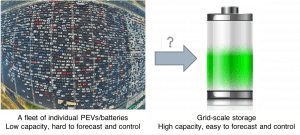With the rapid development of smart meters and advanced control technologies, DERs such as battery storage systems, plug-in electric vehicles (PEVs), and shapeable loads, promise the ability of providing flexibility services to power systems. These services include filling load valleys or arbitraging temporal differences in energy market prices, facilitating integration of renewable energy sources, providing auxiliary services, etc.

Distributed energy resources can provide flexibility to smart power grid
Among different grid services, regulation or load-following services are often the most lucrative in many power markets, e.g., PJM. However, the energy and power capacities of DERs are comparatively small, while most regulation markets require high power capacities to access the market. Therefore, a large population of DERs usually have to jointly participate in a regulation market under the coordination of an aggregator. During market operations, the aggregator first evaluates its DERs’ available regulation capacities, and then bundles the services from those DERs as a bid in the market. During real-time operations, the aggregator receives regulation signals from the system operator, and is responsible for adjusting the power consumed by the DERs to follow these signals while respecting each DER’s parameters, e.g., load demands and rated power and energy capacities etc.

Vehicle-to-grid may be an ideal way for EV flexibility utilization
However, utilizing DERs’ flexibility is not easy. The aggregator is faced with the difficult challenge of constructing a profit-maximizing bid to the power market, because of three major reasons: 1) Forecasting DERs’ behaviors and evaluating their flexibility is difficult because of their stochastic characteristics; 2) DERs usually have small power and energy capacities but very large scales (in thousands or even millions), jointly optimizing their aggregated power consumption suffers from the “curse of dimensionality”; 3) Even, an aggregated power schedule can be obtained for all the DERs, coordinating/controlling thousands of them to realize that schedule during realtime operation is also quite challenging.

With proper controlling techniques, large-scale DERs can jointly provide services to power grid like a grid-scale storage system
The smart energy group has been actively working on relevant topics on DER flexibility utilization based on Internet of Things Technology. We have made significant achievements in aggregate modeling and forecasting of DER flexibility, power scheduling and distributed controlling, and power market participation etc. Welcome to read the following publication for more details.
Relevant publication
- Ding, Y. Song, H. Hui, and C. Shao. “Integration of Air Conditioning and Heating into Modern Power Systems.” Springer, 2019.
- Jia, Y. Ding, Y. Song, C. Singh and M. Li, “Operating Reliability Evaluation of Power Systems Considering Flexible Reserve Provider in Demand Side,” in IEEE Transactions on Smart Grid, vol. 10, no. 3, pp. 3452-3464, May 2019.
- Zhang, Z. Hu, E. Munsing, S. J. Moura and Y. Song, “Data-Driven Chance-Constrained Regulation Capacity Offering for Distributed Energy Resources,” in IEEE Transactions on Smart Grid, vol. 10, no. 3, pp. 2713-2725, May 2019.
- Cui, Y. Ding, H. Hui, Z. Lin, P. Du, Y. Song and C. Shao, “Evaluation and Sequential Dispatch of Operating Reserve Provided by Air Conditioners Considering Lead–Lag Rebound Effect,” in IEEE Transactions on Power Systems, vol. 33, no. 6, pp. 6935-6950, Nov. 2018.
- Chen, H. Zhang, Z. Xu, C. P. Nielsen, M. B. McElroy, and J. Lv, “Impacts of Fleet Types and Charging Modes for Electric Vehicles on Emissions under Different Penetrations of Wind Power,” Nature Energy, vol. 3, pp. 413-421, 2018.
- Zhang, Z. Hu, Z. Xu, and Y. Song, “Evaluation of Achievable Vehicle-to-Grid Capacity Using Aggregate PEV Model,” IEEE Transactions on Power Systems, vol. 32, no. 1, pp. 784-794, 2017.




